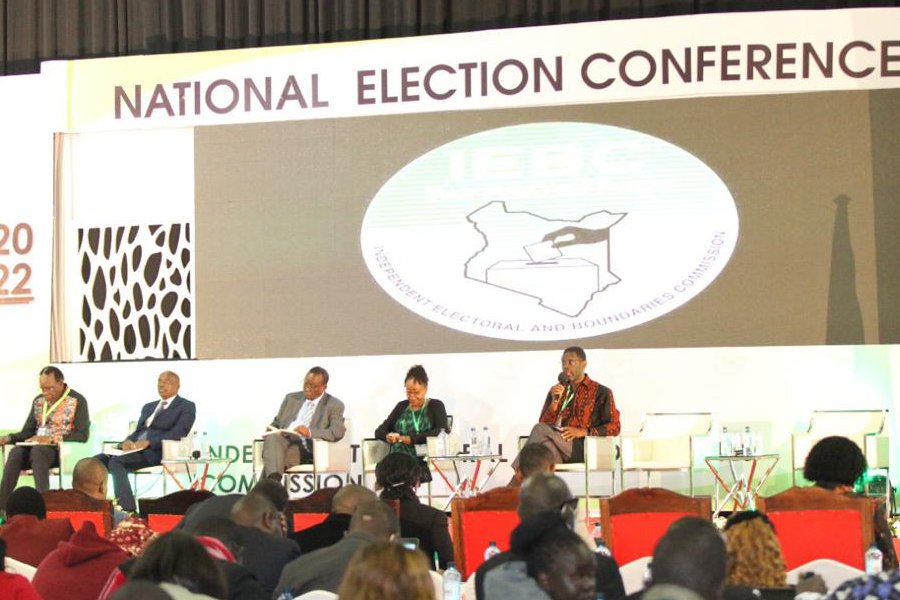KICTANet participated in the 2022 National Election Conference held on 11 and 12 July at the KICC in Nairobi. The theme of the conference was “Moving Kenya towards a stronger democracy”.
Grace Githaiga and John Walubengo participated in a panel session during the conference titled electoral technology. The objectives of the session were to: examine the role of technology in the electoral process; sensitize members of the public on developments in electoral technology in elections; inform the national stakeholders on concrete dispositions to address challenges from previous elections from a continuous improvement perspective; and raise awareness on regional and international trends, challenges, and good practices on elections technology. The event was attended by at least 700 stakeholders from across the country.
During the session, they highlighted key concerns relating and technology and elections including those that KICTANet had highlighted in its previous observation missions during past elections.
Notably, in every election since 2013, KICTANet has deployed technology observers to help understand how technology is used in the Kenyan elections, and provide gaps and recommendations for improvement. This year 2022 will not be any different. KICTANet has already enlisted over 50 observers in different parts of the country.
Lesson from 2017
In 2017, the Kenyan Presidential election was nullified. Was there any technological failure? And if so, what measures have been put in place? The opposition challenged the Presidential results in the Supreme Court, arguing that the electronic system was hacked, resulting in manipulation of the voting system. The KICTANet observers in 2017 note that;
- Not all voters were identified using biometrics. There was a small number whose fingerprints could not be read by the KIEMS kit either due to cuts on their hands or because of too much manual work.
- Many of the polling clerks had challenges with the KIEMS kits and sometimes would take ten minutes to process a single individual. An interview with them revealed that the training of the kits had been conducted hurriedly and just a few days before the polls.
- The electronic results transmission to the constituency tally centers, county tally centers, and the national tally center presented challenges in places with poor internet network coverage. Indeed, most operational problems reported during the August election were at the results transmission stage.
- At the tallying centers, there were screens where results from different polling stations were displayed, although not in real-time.
- There were polling stations whose results were not displayed on the IEBC results transmission portal. The explanation offered was that some stations faced network challenges, resulting in delayed transmission. This made it difficult to compare observed results with results at the tallying center as electronic display screens were limited.
- Both the August election and the repeat Presidential election were characterized by a high level of online misinformation. There were coordinated attacks against political parties, politicians, and political institutions. Politicians engaged in hate speech during this period which was amplified on social media, with the public petitioning for their arrest.
Role of ICT in elections
KICTANet points out that the IEBC has the responsibility to ensure:
- That the technology used in electoral systems works, including in areas not covered by any internet or cellular networks, by say deploying satellite networks.
- The people running the systems are not of questionable integrity. General elections integrity: Citizens’ confidence in IEBC will exist when citizens are assured that IEBC will honour its mandate of ensuring a tamper-free elections process.
- Technology audit of the electoral systems is conducted to identify points of failure. e.g failure of devices, or network.
- There is redundancy and back up for instance through ensuring multiple vendors and service providers. Additionally, ensuring the procurement process does not limit redundancy
- There is better public engagement, including continuous engagement with the technology community.
- They inform the public of their strategic plan, the capabilities of the systems they have procured, and how they mainstream long-term stability in the same systems (fungua server).
- Implement a public online portal to show actual text results and copies of the physical result forms as received.
- Provide access to election data to researchers post-election.
- Make use of technology platforms such as their website as the primary source of information and augment this with their social media platforms to ensure greater access to information and reach of the public. The information should also be in simplified and accessible formats.
- Protect and secure all the personal information collected and processed for purposes of the election.
![]()




